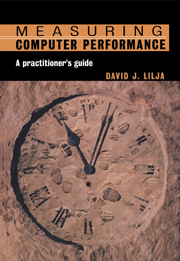Book contents
- Frontmatter
- Contents
- Preface
- Acknowledgements
- 1 Introduction
- 2 Metrics of performance
- 3 Average performance and variability
- 4 Errors in experimental measurements
- 5 Comparing alternatives
- 6 Measurement tools and techniques
- 7 Benchmark programs
- 8 Linear-regression models
- 9 The design of experiments
- 10 Simulation and random-number generation
- 11 Queueing analysis
- Appendix A Glossary
- Appendix B Some useful probability distributions
- Appendix C Selected statistical tables
- Index
1 - Introduction
Published online by Cambridge University Press: 15 December 2009
- Frontmatter
- Contents
- Preface
- Acknowledgements
- 1 Introduction
- 2 Metrics of performance
- 3 Average performance and variability
- 4 Errors in experimental measurements
- 5 Comparing alternatives
- 6 Measurement tools and techniques
- 7 Benchmark programs
- 8 Linear-regression models
- 9 The design of experiments
- 10 Simulation and random-number generation
- 11 Queueing analysis
- Appendix A Glossary
- Appendix B Some useful probability distributions
- Appendix C Selected statistical tables
- Index
Summary
‘Performance can be bad, but can it ever be wrong?’
Jim Kohn, SGI/Cray Research, Inc.Measuring performance
If the automobile industry had followed the same development cycles as the computer industry, it has been speculated that a Rolls Royce car would cost less than $100 with an efficiency of more than 200 miles per gallon of gasoline. While we certainly get more car for our money now than we did twenty years ago, no other industry has ever changed at the incredible rate of the computer and electronics industry.
Computer systems have gone from being the exclusive domain of a few scientists and engineers who used them to speed up some esoteric computations, such as calculating the trajectory of artillery shells, for instance, to being so common that they go unnoticed. They have replaced many of the mechanical control systems in our cars, thereby reducing cost while improving efficiency, reliability, and performance. They have made possible such previously science-fiction-like devices as cellular phones. They have provided countless hours of entertainment for children ranging in age from one to one hundred. They have even brought sound to the common greeting card. One constant throughout this proliferation and change, however, has been the need for system developers and users to understand the performance of these computer-based devices.
While measuring the cost of a system is usually relatively straightforward (except for the confounding effects of manufacturers' discounts to special customers), determining the performance of a computer system can oftentimes seem like an exercise in futility.
- Type
- Chapter
- Information
- Measuring Computer PerformanceA Practitioner's Guide, pp. 1 - 8Publisher: Cambridge University PressPrint publication year: 2000

